 Outdoor Himalayan
Outdoor Himalayan Treks
info@outdoorhimalayan.com
badri@outdoorhimalayan.com
Mera Peak climbing
Cost USD 1990.00 Per Person based on 2 travelers
Organized by Local Operator |  100% Customer Satisfaction
100% Customer Satisfaction
Mera Peak (6,470 m) Victorious, Challenging, Joyful- Ascending Highest Nepal's Trekking Peak
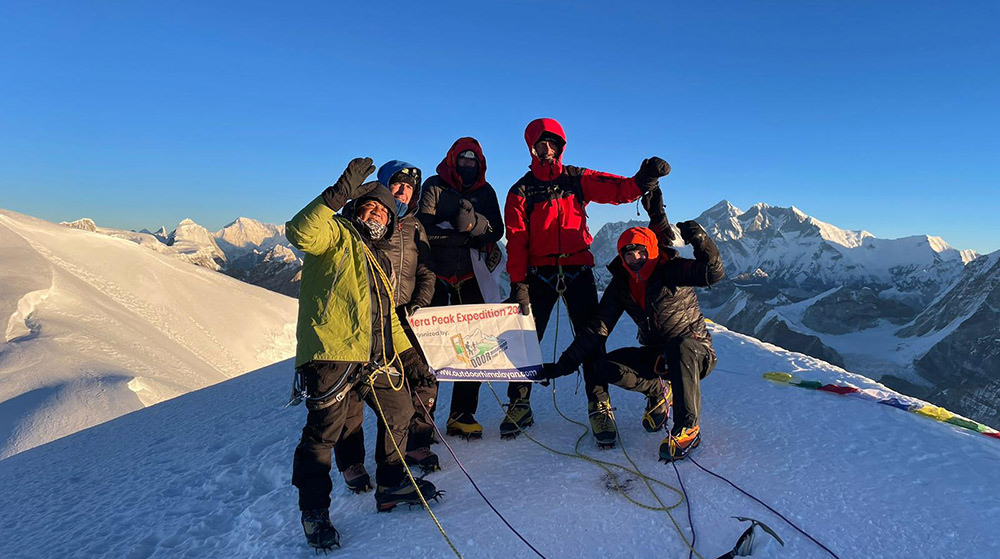
Why Mera Peak?
- The highest trekking peak Mera Peak itself at an elevation of 6,470 m.
- Incredible views of Everest, Lhotse, Makalu, Cho Oyu, and Kanchenjunga- (all above 8,000 meters)
- Traversing through two amazing national parks- Makalu Barun and Sagarmatha National Park
- Varied flora and fauna in the national park’s surroundings
- Picturesque vistas of diverse landscapes, snow-capped mountains, local villages Sherpa people and their culture, tradition, and lifestyle
Mera Peak in Nepal is one of the popular trekking peaks standing at an elevation of 6,470 meters. It lies in the Mahalangur section of the Himalayas Nepal boasts multiple climbingpeaks above 6000 meters. This peak is crowned as the ‘highest trekking peak’ in Nepal.The peak has three different routes to choose from for the summit; the central route being the most popular.
Mera Peak climbing is challenging but it treats mountaineers with incredible views of mountains above 8,000 meters, Lhotse, Makalu, Cho Oyu, and Kanchenjunga. Not only this, it is surrounded by numerous mountains and phenomenal scenery. Since it is suitable for beginners, it is several mountaineers’ first choice for climbing peaks in Nepal. Traverse through the amazing two national parks Makalu Barun and Sagarmatha and appreciate the varied flora and fauna in the vicinity. This Mera Peak Climbing ensures mountaineers with unforgettable memories and lasting experiences with the scenes and lifestyle of the Himalayas of Nepal.
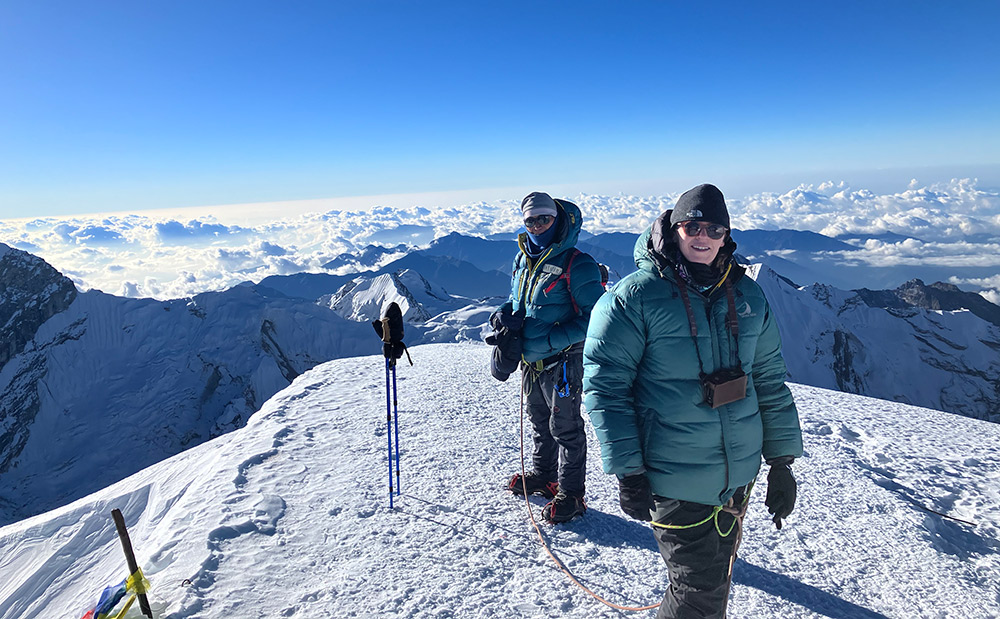
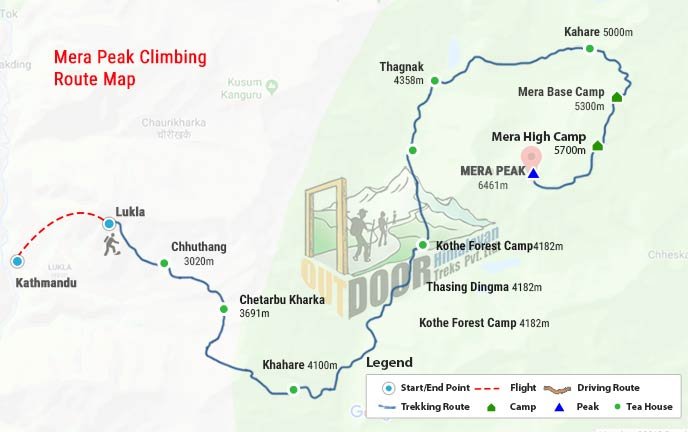
Suggested Itinerary
This itinerary listed is a guideline & standard pattern which we provide, can be modify as your requirements. Leave your message for tailor-made tour itinerary.
Day 01: Arrival in Kathmandu
On your arrival at Tribhuvan International Airport in Kathmandu, an Outdoor Himalayan Treks representative will receive you and transfer you to your hotel. If there is enough time left,
you can get fresh and take a quick tour of the city.
Day 02: Document preparation day
Trip and documentation preparation day. Check the climbing gears, and meet with the Guide. Later, explore the town on your own.
Day 03: Kathmandu to Ramechap Drive, Ramechap- Lukla flight, trek Paiya (2730m)
Meet the Guide at 2 AM and head to Ramechap airport for our flight to Lukla. Following the morning flight, we'll enjoy breakfast at a
lodge before setting off towards Paiya, our stop for the night. The trek to Paiya typically lasts around 5-6 hours
Day 04: Paiya to Panggom (3200 Mtrs)
Resume trekking after a quick breakfast in the morning and arrive at Panggom for overnight 6 hours.
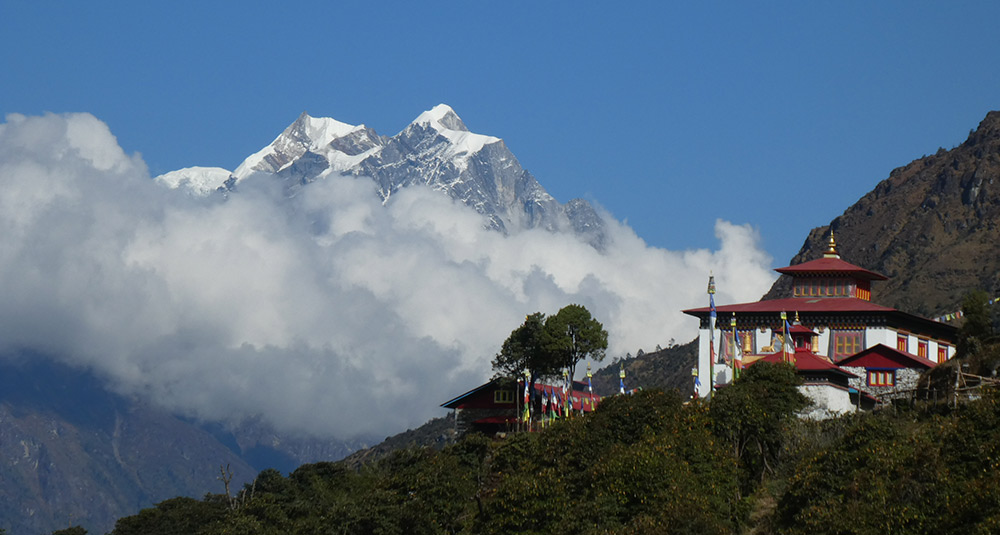
Day 05: Panggom to Ramailo Dada
Continue the journey, and walk towards Ramailo Danda.
Day 06: Ramailo Danda to Chatra Khola
After breakfast, trek to Chatra Khola for an overnight which takes about 5 hours.
Day 07: Chatra Khola to Kothe
After breakfast, trek to Kothe for an overnight which takes around 6 hours.
Day 08: Kothe- Thaknak (4356m)
TThe day for walking from Kothe to Thaknak takes about 5-6 hours.
Day 09: Thaknak - Khahare (5045m)
Trek to Khahare which takes about 6-7 hours.
Day 10: Khahare acclimatization day.
This is an acclimatization day. During the day you will hike up and back to Khare for the overnight.
Day 11: Khare- Mera La High Camp (5780m)
Today's trek can get a bit strenuous as we climb our way up to Mera La (High Camp).
Day 12: Summit the Peak of Mera and back to Khare
Follow the instructions given by your guide and climb your way up to the peak of Mera. Then back down to Khare. We keep one spare day in High Camp just in case of the
weather conditions. If the weather remains good you will reach the top of Mera Peak (6461m) and back to Khare the same day. If required, you can stop for one more day in High Camp and get to the summit of Mera Peak.
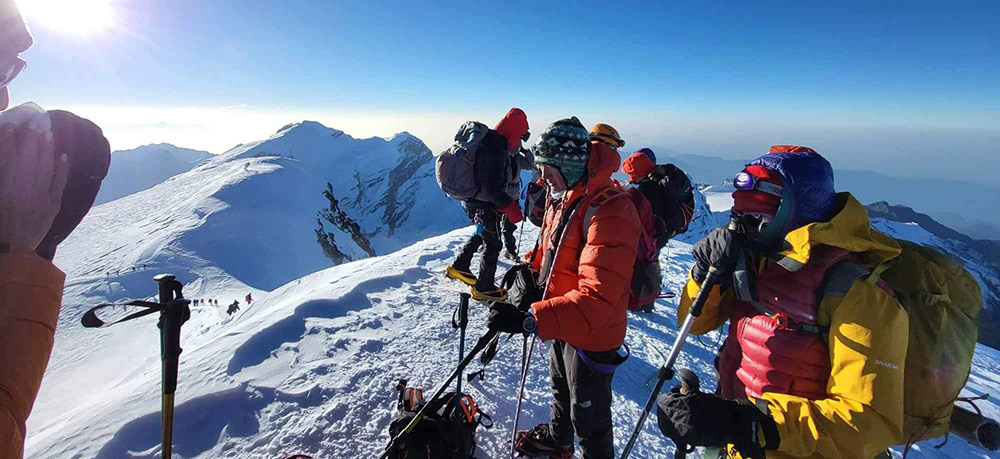 |
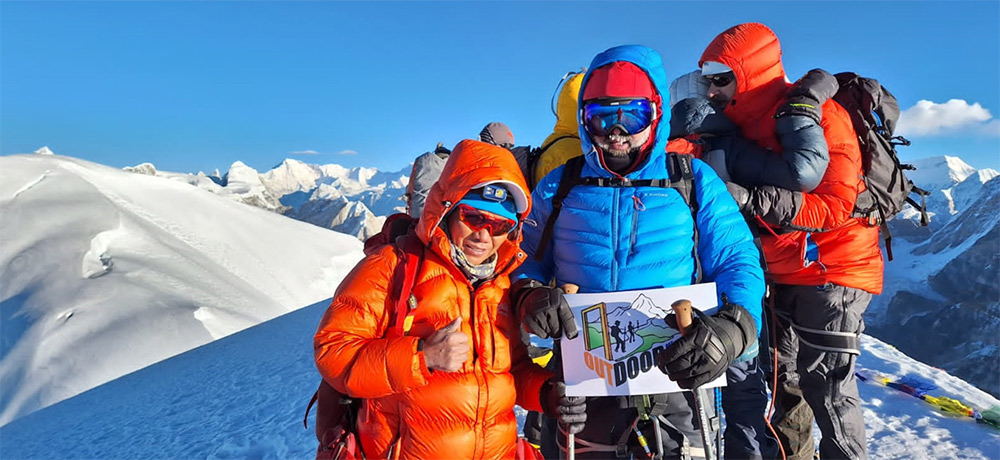 |
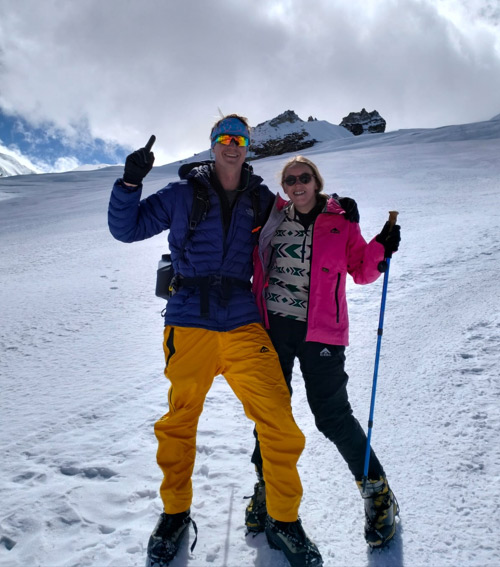
|
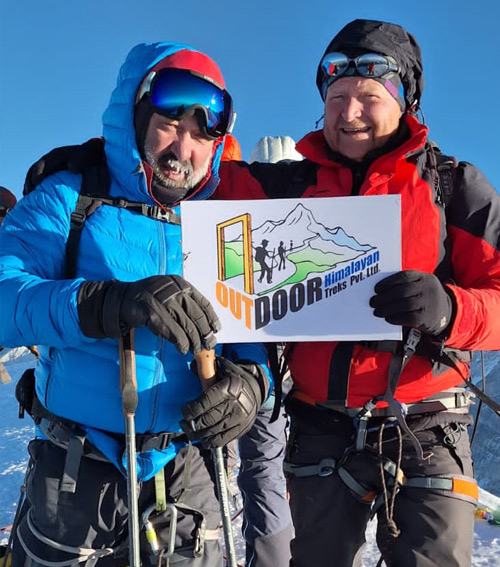
|
Day 13: Khare to Kothe
Trek down to Kothe from Khare.
Day 14: Kothe to Thuli Kharka Resume
Walk down to Thuli Kharka.
Day 15: Thuli Kharka to Lukla
Resume walk down to Lukla takes about 7-8 Hours. Check in to a lodge in Lukla. Enjoy the evening in Lukla town. Night at the lodge.
Day 16: Lukla- Ramechap, Ramechap to Kathmandu Drive, farewell dinner
in the evening.
Catch the early morning flight from Lukla Airport to Ramechap. After that flight, drive to Kathmandu, and transfer to the hotel. Join the farewell dinner offered by Outdoor Himalayan Treks in the evening.
Day 17: Departure Transfer
If you are leaving Kathmandu by air, we will transfer you to the airport. You may extend your stay if you like.

Cost Includes (USD 1990 per person based on 2 PAX) the cost for solo travelers and bigger size groups will be different.
- Accommodation: Basic teahouse accommodation during the trek (Toilet and bathroom will be outside of the room; Deluxe accommodation for 3 nights in Kathmandu with Breakfast. And tented camp during the climbing.
- Meals: 3 meals per day breakfast, lunch, and dinner, which you can choose from the menu during the trek. Breakfast in Kathmandu and Our climbing guide will provide you the meals during the climbing periods.
- Transportation: Kathmandu-Ramechap-Kathmandu by Private Transportation, Ramechap to Lukla to Ramechap both-way flight tickets. Airport - hotel - airport transfers by private transportation.
- Documentation: Trekking permit (Sagarmatha National Park permit), Khumbu village entry permit (local permit), and Mera Peak climbing special permit.
- Equipment/Accessories: first-aid kit, water purifying solution (iodine-based), Tent, ice axe, Harness, Snow bar, main rope and fixed rope, Crampons, etc.
- Human resource: A professional and experienced Climbing guide (English-speaking), and a porter for the 2 of you (each porter carries up to 25 kilos); including all the expenses for the guide and porter (wages, accommodation, meals, transportation, insurance, etc.), High altitude worker’s special insurance & climbing bonus for the Sherpa is included as well.
- Tax/Service Charge: All applicable taxes, service charges, or fees. We hereby guarantee you no 'hidden charges' afterward.
- Complimentary: Farewell dinner in Kathmandu (authentic Nepalese cuisines with live cultural show or food of your preference)
- Emergency Rescue Service: Should any emergency arise during your trek, we will provide prompt and professional rescue and medical services. However, you must be already insured for such emergencies, and your insurance policy must cover helicopter evacuation. Moreover, you should provide your policy details and authorize us to deal directly with your insurance company on your behalf.
Cost does not include
- Beverage (cold drinks, bottled mineral water, tea/coffee, etc.)
- Any other expenses of a personal nature (extra meals/snacks/desserts, battery charging fees, photography charges, Hot Shower, etc.)
- Personal equipment for trekking and climbing (Trekking shoes, climbing boots, warm clothes, etc.)
- Extra porter (if required, costs USD 25 per porter per day)
- Tips for guide and porter (mandatory)
- Your travel insurance
- Nepal Visa
- Excess luggage’s cargo charge on the domestic flight. (The airline allows 15Kg per person if you have extra then USD 1.00 per Kg will be applied)
- Any extra services mentioned above and any costs arising due to bad weather, natural disasters, political problems, etc., unsuccessful summit due to personal issues, early/late arrival/departure due to delays/cancellation of the flight, etc.
Note: The cost for a bigger group will be lower than the above-mentioned, so for any customization and bigger group with extra services kindly contact us. This trip is available until 21st March 2024
Everest Base Camp trek with Helicopter
(Minimum 2 Trekkers, Private trip, Heli & Plane might be in sharing basic)
Option 1: Single Day Everest Base Camp Helicopter Landing Tour
(Group Joining, Departing Every day) USD 1400 Per Person
Option 2: 9 days trek to Everest Base camp & return back by Helicopter from Gorakshep to Kathmandu USD 2875 Per Person
Option 3: 13 days Classic Everest Trek (Ktm-Lukla-Ktm by plane) USD 1400 Per Person
(upgraded hotels option: USD 1590 per person)
Why book with us?
Outdoor Himalayan Treks, Founded by professionals with long experience in adventure and community-based tourism, the company is dedicated to delivering high-quality service to its clients.Experiences since 2004, 75% Repeated customers, Awarded on TripAdvisor
Travel Guidelines for Mera Peak Climbing
Accommodation at Mera Peak Climbing:
- Basic teahouse accommodation during the trek.
- The toilet and bathroom are outside the room at a high altitude.
- Tented camp during the climbing period.
Food at Mera Peak Climbing:
- 3 meals per day (breakfast, lunch, and dinner) during the trek.
- Meals are prepared and served by the crew during the climbing period.
Drinking water at Mera Peak Climbing:
Drinking water is plentiful in the Khumbu region. The natural spring water from the Himalayas can be used as drinking water. You can fill it at the water taps, or teahouses. Always
carry a drinking water bottle and water purifying tablets for your safety.
Communication at Mera Peak Climbing:
The internet connectivity and phone networks are fine in the lower regions. But, in higher regions, it may be unstable.
Best time for Mera Peak Climbing:
Spring (Mar-May) and Autumn (Sep-Nov) seasons are the best time for peak climbing in Nepal. The clear skies, beautiful weather, bright days, and dry but comfortable walking trail
are the best part of these seasons. During these seasons, the views are mesmerizing and abundant with seasonal vegetation. For ascending, stable weather and moderate temperature are the prime factor to consider spring and autumn as
the best time for Mera Peak Climbing.
Mera Peak Climbing Trek Difficulty
Mera Peak climbing difficulty is moderate level. Peak climbing is demanding task but achievable with good preparations. The mountaineer with a good physical condition and prior experience
can easily ascend this Mera Peak. The trails are rough and contain steep ascend and descend which are challenging for mountaineers. The best part of this peak climbing is it is not very technical. Only at few sections, use of equipment
and gear is required. Take proper guidelines, participate in physical exercises, and if necessary consult with a doctor before participating in the Mera Peak Climbing.
Altitude Sickness during Mera Peak Climbing
Altitude sickness or acute mountain sickness (AMS) is common above an elevation of 2500 m in the mountains. As the altitude rises, oxygen level declines, and air pressure
also lowers which affects the body’s functions causing altitude sickness. Since this is a peak climbing, suffering from altitude sickness is high but with proper precautions and preparation it is preventable.
Symptoms of Altitude Sickness
Symptoms of altitude sickness can vary from person to person, but common symptoms include:
- Headache
- Dizziness or lightheadedness
- Fatigue or weakness
- Shortness of breath or difficulty breathing
- Loss of appetite or nausea
- Insomnia or difficulty sleeping
- Swelling of the hands, feet, and face
- Preventive Guidelines for Altitude Sickness
Some preventive guidelines to prevent altitude sickness for the Mera Peak Climbing are as follows:
- Acclimatize gradually for adjusting to the surroundings
- Stretch the body and do some warm-ups before the trek
- Ascend slowly to give the body time to acclimatize
- Drink plenty of fluids to prevent Dehydration and urinate frequently to help the body function properly
- Avoid alcohol and caffeine, and salty foods
- Avoid strenuous activity
- Get plenty of rest to allow the body time to recover and adjust to the lower oxygen levels
- Make sure to get plenty of sleep and take regular breaks to rest
- Use an oxygen cylinder if necessary in case of difficulty
- Immediately consult with a guide and seek medical attention if necessary
CANCELLATION
- Free cancellation up to 30 days prior departure
- 40% of the total cost of the trip will be charged if cancelled between 30 to 14 days prior to departure date
- 60% of total cost of the trip will be charged if cancelled in between 14 to 7 days prior to departure date.
- No refund will be provided if cancelled within 7 days prior of departure date.
- No refunded will be provided if the guest will not show up.
- Regrettably, in case where the trek/tour can not be completed due to customer's own problem or sickness or unfavourable weather there will be no refund.
- If the trekking/tour is extended more than given itinerary extra charge will be applied accordingly
- If the agreed trip can not be organised due to bad weather or any unforeseen events, similar trip will be organised (in the mutual understanding with the travellers)
For additional information, related trip options, FAQs, weather and more, please visit our website from here
Why Book with Us?

100% Customer Satisfaction see reviews
- Dedicated Local Organization of experts service since 2004
- Highly rated in TripAdvisor with over 75% of return customers
- Motto of Satisfaction before benefits
- Aiding your pre and post tour preparations
- Compatible with the changes with our expert backups
- Best Guides: Attentive and up to date
- Hassle free abstract service with Optimum use of your resources
- No hidden charges with transaction transparency
Everest Base Camp treking Options
Heli Out (Minimum 2 Trekkers, Private trip, Helicopter and Plane might be in sharing basic)Option 1: Single Day Everest Base Camp Helicopter Landing Tour
(Group Joining, Departing Every day) USD 1400 Per Person
Option 1: 9 days trek to Everest Base camp & return back by Helicopter from Gorakshep to Kathmandu USD 2875 Per Person
Option 3: 13 days Classic Everest Trek (Ktm-Lukla-Ktm by plane) USD 1400 Per Person
(upgraded hotels option: USD 1590 per person)
Quick Enquiry
For additional information, related trip options, FAQs, weather and more, please visit our website from here
Contact & Support
Bhagawati Bahal, Thamel
+977 9851059278, 9851059279 (WhatsApp/Viber)
info@outdoorhimalayan.com






